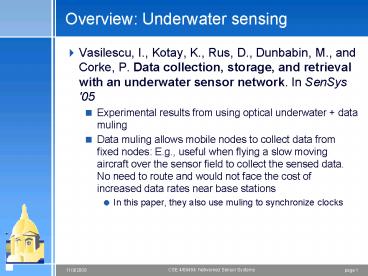Overview: Underwater sensing - PowerPoint PPT Presentation
1 / 12
Title:
Overview: Underwater sensing
Description:
Control hover mode to collect data (visual servoing for starbug and active beaconing by amour) ... Requires mobility to hover and haul data away ... – PowerPoint PPT presentation
Number of Views:114
Avg rating:3.0/5.0
Title: Overview: Underwater sensing
1
Overview Underwater sensing
- Vasilescu, I., Kotay, K., Rus, D., Dunbabin, M.,
and Corke, P. Data collection, storage, and
retrieval with an underwater sensor network. In
SenSys '05 - Experimental results from using optical
underwater data muling - Data muling allows mobile nodes to collect data
from fixed nodes E.g., useful when flying a slow
moving aircraft over the sensor field to collect
the sensed data. No need to route and would not
face the cost of increased data rates near base
stations - In this paper, they also use muling to
synchronize clocks
2
Hardware used - Aquafleck
- Aquafleck - static sensor, water tight, brightly
colored, able to float straight up (so that it
can easily be picked up) - Fleck processor, 512 KB flash for data logging,
4KB RAM - Optical communications 2.2 m or 8 m (with lens)
range, 320 kbps, 30 degree cone - Acoustic module 20 m range for ranging
- Pressure, temperature, camera sensor 255x143
resolution. Not enough storage to store images
and so images are directly uploaded from camera
and sent to the AUV (ie pictures show the AUV and
not other marine objects) - 170mm road for beaconing AUVs (LED) and pickup
- 40 negatively buoyant
3
Hardware used - Amour
- Amour Mobile robot, can pick up aquafleck, not
designed for long distance motion, balanced - http//groups.csail.mit.edu/drl/wiki/index.php/AMO
UR - 4 thrusters, two horizontal, two vertical, 150 W
total - Magnetic compass
4
Hardware used - Starbug
- Starbug (CSIRO) mobile robot, can guide amour to
go for longer distances. Primarily designed with
visual navigation in mind. Endurance,
maneuverability and functionality - 1.2 m long, 6 thrusters, 2 vision heads one
looking down and one looking forward with a 3W
white LED light
5
Application scenario
- Disperse aquaflecks in a reef
- Amours dropped near first aquafleck, amour knows
map of deployment. Rises to surface, uses GPS for
location. Sinks to the bottom, use spiraling
motion to local first aqufleck. Hover and collect
data. Use magnetometer to locate next aquafleck
in a raster fashion. - Starbug hover over amours and hauls data away
- Not described in this paper
6
Interesting observations
- Optical - 320 kB/sec
- Luxeon - 700 mw radiated, 6W input
- Receiver PDB-C156 photo diode senstive to IR and
red!! - 50/node
- Works best in blue-green color range
- Aquaflecks are looking up, towards the sun which
affects the signaling efficiency in shallow
waters - Acoustic -
- WHOI modem - 220 bps, 5 km range, 10W
- Aquacomm - 480 bps, 200 m, 0.45W
- 1.3 days to transmit sensed data of 6.86 MB
- Multihop would require 6.2MJ
- 3000/node (I suspect it is the long range modem)
- As discussed in last class affected by waves,
sound etc.
7
Experimental characterization of optical
- Possible range
- Clear indoor swimming pool - 8m
- Charles river - highly turbid water - 1m
- Using a 60mm lens and holding the sensors with
hand in clear swimming pool water, achieved 96
reception from 7m range - Harder to achieve with the AUV because of
currents - Energy consumption 1094 nJ/bit
- Mica motes use 760nJ/bit in terrestial wireless
8
Optical ranging component
- Few optical sensors are suited for underwater
because of coupling issues between sensor and
water - Panasonic unit - 20
- Sealed using hot-glue
- Tested under water in swimming pool and Charles
river at depth of 30-40 cm - River 50 Hz at 5.8 m for controlled experiments
- Pulse position modulated data 41 mbps at 15m
9
Data retrieval using mobility
- Locate first sensor - GPS plus spiral motion
- Locate next sensor in sequence - compass active
beacon (amour) and visual (starbug - 5Hz does not
work with depth - requires ambient light) - 5m - Control hover mode to collect data (visual
servoing for starbug and active beaconing by
amour) - Data transfer - 239 byte check-summed packets
- actively transferred to the AUV from camera
- Synchronize clock - global sync harder. All
aquaflecks synchronize with the AUVs - When data collection, compensate for clock drift
using simple numerical averaging
10
Summary
- Under water communication is difficult. Acoustic
has higher range, omnidirectional, higher cost
and lower data rate - Requires multi-hop to reach base station
- Optical has lower range, directional, lower cost
and higher data rate - Requires mobility to hover and haul data away
- Effects of longer term water immersion (slime
buildup) is not addressed. Likely to be more of a
problem for optical communications - Depth of operation issues
- Data hauling and 3D sensing?
- Tethers are an obstacle course for mobility
11
Mobility based sensing
- Lessons learnt from Zebranet to underwater
- Turns out that Zebra rip the solar panel in a few
days - Lessons learnt from underwater to Zebranet
- Hovering in air is much harder - bulky, energy,
noisy - ???
12
Wrapup
- Book outlined important aspects such as
scalability, energy conservation, small size/cost
- Sensors bridge physical and computational worlds
- Depending on the sensed environment, each
manifests differently - Habitat monitoring Duck island - longevity
- Zebranet Mobility induced communication
- Volcano Fidelity of capture is important
- Surveillance Traditional sensing (unless you add
aircraft muling etc.) - Underwater communications is hard
- Acoustic
- Optical with mobility
- Lesson Important to focus on the application
scenario































